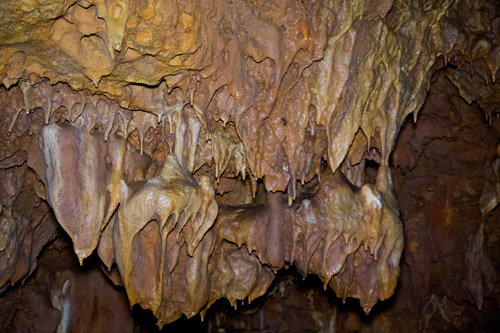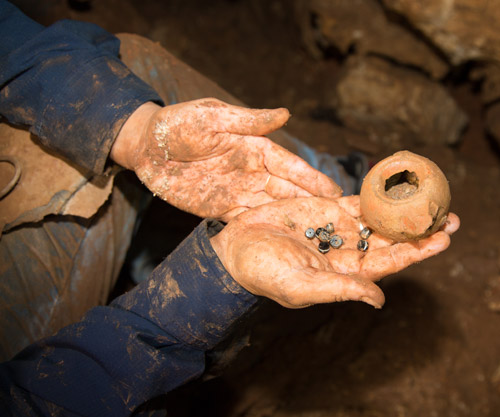(
Israel Antiquities Authority)
A month after the
discovery of the gold treasure by divers off the coast of Caesarea, another report has reached the Israel Antiquities Authority of a find involving a
cache of rare coins and silver and bronze objects 2,300 years old, in a cave in northern Israel. Officials in the Israel Antiquities Authority believe this is
one of the important discoveries to come to light in the north of the country in recent years, and will require much time to study in order to crack the secrets of the cave.
Two weeks ago Reuven Zakai, his son Chen Zakai and their friend Lior Halony, members of the Israeli Caving Club, set out to make preliminary preparations for a visit to one of the largest and well-hidden stalactite caves in the north. The three lowered themselves down in the ground, into the stalactite cave, and wriggled through a narrow passage in front of the cave. They wandered and crawled between the different parts of the cave for several hours.
 Active stalactites in the cave Copyright: Shmuel Magal, courtesy Israel Antiquities Authority
Active stalactites in the cave Copyright: Shmuel Magal, courtesy Israel Antiquities AuthorityThe youngest member of the group, Chen, 21, says he forced his way into one of the narrow niches when he suddenly caught sight of a shining object. There he discovered
two ancient silver coins which it later turned out had been minted during the reign of Alexander the Great who conquered the Land of Israel at the beginning of the Hellenistic period (late 4th century BCE). Several pieces of silver jewelry were found alongside the coins, among them rings, bracelets and earrings, which were apparently concealed in the cave, together inside a cloth pouch some 2,300 years ago.
 Silver coin of Alexander of Macedon (Alexander the Great) Copyright: Shmuel Magal, courtesy Israel Antiquities Authority
Silver coin of Alexander of Macedon (Alexander the Great) Copyright: Shmuel Magal, courtesy Israel Antiquities AuthorityIn the opinion of archaeologists at the Israel Antiquities Authority, "The valuables might have been hidden in the cave by local residents who fled there during the period of governmental unrest stemming from the death of Alexander, a time when the Wars of the Diadochi broke out in Israel between Alexander’s heirs following his death. Presumably the cache was hidden in the hope of better days, but today we know that whoever buried the treasure never returned to collect it."
The spelunkers realized they found an important archaeological discovery and reported it to inspectors of the Unit for the Prevention of Antiquities Theft in the Israel Antiquities Authority. This weekend officials of the Israel Antiquities Authority entered the cave together with members of the Israeli Caving Club. The IAA inspectors were excited to discover evidence of human habitation that occurred in the cave over extended periods.
At this point they believe they have found artifacts in the cave that first date to the Chalcolithic period c. 6,000 years ago; from the Early Bronze Age c. 5,000 years ago, the Biblical period 3,000 years ago and the Hellenistic period approximately 2,300 years ago. Numerous pottery vessels were also discovered in the cave.
In some regions of the cave ancient pottery vessels were found on which stalagmites had developed. Some of the pottery vessels had bonded with the limestone sediments and cannot be separated. The Israel Antiquities Authority reports that the combination of a stalactite cave and archaeological finds is both fascinating and rare. The finds in the cave will allow the researchers - archaeologists and geologists alike - to accurately date both the archaeological finds and the process of stalactite development.
 Photo inside the cave: agate stones that were part of a string of beads and the Hellenistic oil lamp in which the stones were keptCopyright: Shmuel Magal, courtesy Israel Antiquities Authority
Photo inside the cave: agate stones that were part of a string of beads and the Hellenistic oil lamp in which the stones were keptCopyright: Shmuel Magal, courtesy Israel Antiquities AuthorityAmir Ganor, director of the Unit for the Prevention of Antiquities Robbery in the Israel Antiquities Authority wants to commend the three members of the caving club, "They understood the importance of the archaeological discovery and exhibited exemplary civic behavior by immediately bringing these impressive archaeological finds to the attention of the IAA. After the gold treasure from Caesarea, this is the second time in the past month that citizens have reported significant archeological finds and we welcome this important trend. Thanks to these citizens' awareness, researchers at the Israel Antiquities Authority will be able to expand the existing archaeological knowledge about the development of society and culture in the Land of Israel in antiquity."
Officials in the Israel Antiquities Authority want the location of the cave to remain secret because of the many hazards inside it. Apart from the concern that the archaeological strata and stalactites might be damaged, there is a real danger to visitors to the cave because there are hidden and extremely deep underground cavities in it through which one might fall. In addition, the Israel Antiquities Authority wishes to stress that crawling in caves is dangerous and requires appropriate training and safety equipment.